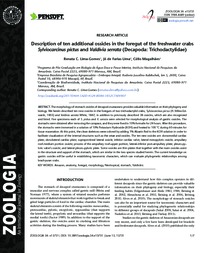Description of ten additional ossicles in the foregut of the freshwater crabs Sylviocarcinus pictus and Valdivia serrata (Decapoda: Trichodactylidae).
Description of ten additional ossicles in the foregut of the freshwater crabs Sylviocarcinus pictus and Valdivia serrata (Decapoda: Trichodactylidae).
Author(s): LIMA-GOMES, R. C.; LIMA, J. de F.; MAGALHÃES, C.
Summary: The morphology of stomach ossicles of decapod crustaceans provides valuable information on their phylogeny and biology. We herein described ten new ossicles in the foreguts of two trichodactylid crabs, Sylviocarcinus pictus (H. Milne-Edwards, 1853) and Valdivia serrata White, 1847, in addition to previously described 38 ossicles, which are also recognized and listed. Five specimens each of S. pictus and V. serrata were selected for morphological analysis of gastric ossicles. The stomachs were obtained after removing the carapace, and they were fixed in 10% formalin for 24 hours. After this procedure, the stomachs were immersed in a solution of 10% Potassium Hydroxide (KOH) and heated to 100 °C during 60 minutes for tissue maceration. At this point, the clean skeletons were colored by adding 1% Alizarin Red to the KOH solution in order to facilitate visualization of the internal structures such as the setae and ossicles. The ten new ossicles are: dorsomedial cardiac plate; dorsolateral cardiac plate; suprapectineal lateral ossicle; inferior cardiac valve; lateral mesopyloric ossicle; ampullary roof-medium portion ossicle; process of the ampullary roof-upper portion; lateral-inferior post-ampullary plate; pleuro-pyloric valve?s ossicle; and lateral pleuro-pyloric plate. Some ossicles are thin plates that together with the main ossicles assist in the structure and support of the stomach, which are similar in the two species studied herein. The current knowledge on gastric ossicles will be useful in establishing taxonomic characters, which can evaluate phylogenetic relationships among brachyuran crabs.
Publication year: 2017
Types of publication: Journal article
Unit: Embrapa Amapá
Keywords: Anatomia, Anatomy, Caranguejo, Crab, Crustacean, Crustáceo, Morfologia, Morphology
Observation
Some of Embrapa's publications are published as ePub files. To read them, use or download one of the following free software options to your computer or mobile device. Android: Google Play Books; IOS: iBooks; Windows and Linux: Calibre.
Access other publications
Access the Agricultural Research Database (BDPA) to consult Embrapa's full library collection and records.
Visit Embrapa Bookstore to purchase books and other publications sold by Embrapa.

